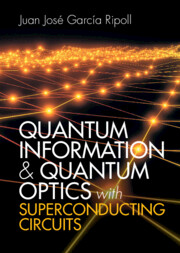Refine search
Actions for selected content:
3286 results in Quantum Physics, Quantum Information and Quantum Computation
Index
-
- Book:
- Quantum Information and Quantum Optics with Superconducting Circuits
- Published online:
- 04 August 2022
- Print publication:
- 18 August 2022, pp 223-302
-
- Chapter
- Export citation
4 - Quantum Circuit Theory
-
- Book:
- Quantum Information and Quantum Optics with Superconducting Circuits
- Published online:
- 04 August 2022
- Print publication:
- 18 August 2022, pp 34-62
-
- Chapter
- Export citation
3 - Superconductivity
-
- Book:
- Quantum Information and Quantum Optics with Superconducting Circuits
- Published online:
- 04 August 2022
- Print publication:
- 18 August 2022, pp 19-33
-
- Chapter
- Export citation
1 - Introduction
-
- Book:
- Quantum Information and Quantum Optics with Superconducting Circuits
- Published online:
- 04 August 2022
- Print publication:
- 18 August 2022, pp 1-6
-
- Chapter
-
- You have access
- Export citation
2 - Quantum Mechanics
-
- Book:
- Quantum Information and Quantum Optics with Superconducting Circuits
- Published online:
- 04 August 2022
- Print publication:
- 18 August 2022, pp 7-18
-
- Chapter
- Export citation

Quantum Information and Quantum Optics with Superconducting Circuits
-
- Published online:
- 04 August 2022
- Print publication:
- 18 August 2022
56 - Fock Space Calculation with Field Operators
- from Part IIe - Many Particles
-
- Book:
- Quantum Mechanics
- Published online:
- 22 December 2022
- Print publication:
- 04 August 2022, pp 623-631
-
- Chapter
- Export citation
20 - Systems of Identical Particles
- from Part I - Formalism and Basic Problems
-
- Book:
- Quantum Mechanics
- Published online:
- 22 December 2022
- Print publication:
- 04 August 2022, pp 229-239
-
- Chapter
- Export citation
26 - Bohr–Sommerfeld Quantization
- from Part I - Formalism and Basic Problems
-
- Book:
- Quantum Mechanics
- Published online:
- 22 December 2022
- Print publication:
- 04 August 2022, pp 290-300
-
- Chapter
- Export citation
24 - Motion in a Magnetic Field, Hall Effect and Landau Levels
- from Part I - Formalism and Basic Problems
-
- Book:
- Quantum Mechanics
- Published online:
- 22 December 2022
- Print publication:
- 04 August 2022, pp 272-281
-
- Chapter
- Export citation
39 - Application: Interaction with (Classical) Electromagnetic Field, Absorption, Photoelectric and Zeeman Effects
- from Part IIb - Approximation Methods
-
- Book:
- Quantum Mechanics
- Published online:
- 22 December 2022
- Print publication:
- 04 August 2022, pp 436-446
-
- Chapter
- Export citation
13 - Symmetries in Quantum Mechanics II: Discrete Symmetries and Internal Symmetries
- from Part I - Formalism and Basic Problems
-
- Book:
- Quantum Mechanics
- Published online:
- 22 December 2022
- Print publication:
- 04 August 2022, pp 149-158
-
- Chapter
- Export citation
14 - Theory of Angular Momentum I: Operators, Algebras, Representations
- from Part I - Formalism and Basic Problems
-
- Book:
- Quantum Mechanics
- Published online:
- 22 December 2022
- Print publication:
- 04 August 2022, pp 159-171
-
- Chapter
- Export citation
54 - The Dirac Equation
- from Part IIe - Many Particles
-
- Book:
- Quantum Mechanics
- Published online:
- 22 December 2022
- Print publication:
- 04 August 2022, pp 603-613
-
- Chapter
- Export citation
Part I - Formalism and Basic Problems
-
- Book:
- Quantum Mechanics
- Published online:
- 22 December 2022
- Print publication:
- 04 August 2022, pp 1-2
-
- Chapter
- Export citation
Part IIe - Many Particles
-
- Book:
- Quantum Mechanics
- Published online:
- 22 December 2022
- Print publication:
- 04 August 2022, pp 601-602
-
- Chapter
- Export citation
30 - Quantum Entanglement and the EPR Paradox
- from Part IIa - Advanced Foundations
-
- Book:
- Quantum Mechanics
- Published online:
- 22 December 2022
- Print publication:
- 04 August 2022, pp 339-349
-
- Chapter
- Export citation
29 - General Theory of Quantization of Classical Mechanics and (Dirac) Quantization of Constrained Systems
- from Part I - Formalism and Basic Problems
-
- Book:
- Quantum Mechanics
- Published online:
- 22 December 2022
- Print publication:
- 04 August 2022, pp 325-336
-
- Chapter
- Export citation
38 - Time-Dependent Perturbation Theory: Second and All Orders
- from Part IIb - Approximation Methods
-
- Book:
- Quantum Mechanics
- Published online:
- 22 December 2022
- Print publication:
- 04 August 2022, pp 429-435
-
- Chapter
- Export citation
49 - Unitarity, Optics, and the Optical Theorem
- from Part IId - Scattering Theory
-
- Book:
- Quantum Mechanics
- Published online:
- 22 December 2022
- Print publication:
- 04 August 2022, pp 547-556
-
- Chapter
- Export citation
